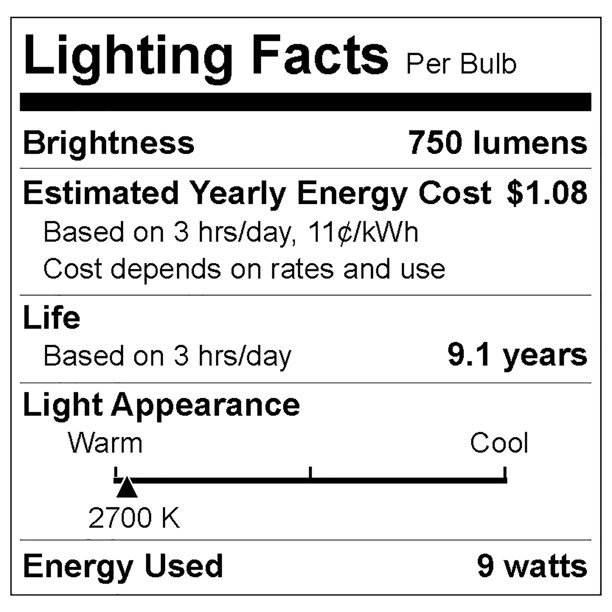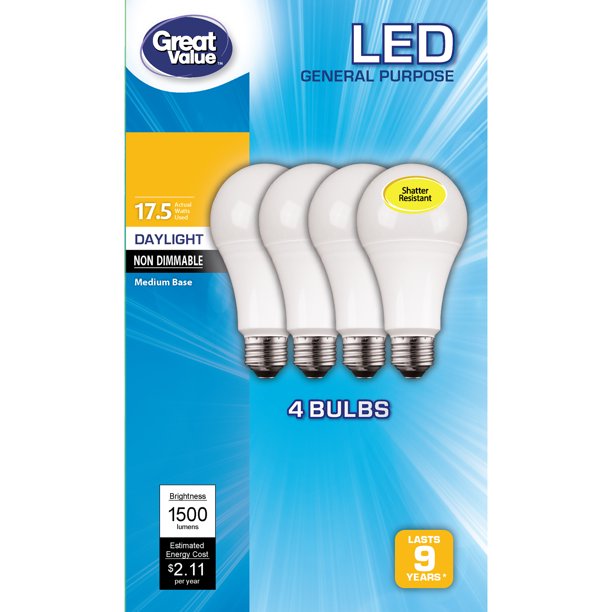LEDs use much less energy than incandescent bulbs because diode light is much more efficient, power-wise, than filament light. LED bulbs use more than 75% less energy than incandescent lighting. At low power levels, the difference is even larger.
LED vs. regular lightbulbs:
Do they really make a difference?
If you have found yourself in the market for new lightbulbs recently, you have likely faced what seems like infinite options. Recent innovations have brought us all kinds of new light technology. From lightbulbs designed to react to sound waves (yep) to those intended to fight off deadly bacteria (seriously, this is a real thing!), what used to be a simple source of light continues to evolve.
But when you simply need a new bulb for your bedside lamp, how do you know that you are making the right decision? Which light bulbs are designed to be better for the environment, and to help us cut back on our electric bills?
We tackle these and other frequently asked questions about lightbulbs below. The simple fact is that LED bulbs use 75% less energy than incandescent lighting.
What are my options when it comes to lightbulbs?
In one word: many! But here are three of the most popular:
- Incandescent bulbs: These are the old-fashioned, “typical” bulbs that many of us grew up with. They are not very energy-efficient and they do not last long.
- Compact fluorescent lightbulbs (CFLs): These are the “spiral” bulbs that may come to mind when we think about energy-efficient bulbs.
- LEDs: LED bulbs are very energy-efficient but still maintain the look and feel of an incandescent bulb.
Incandescent, CFL, and LED bulbs all require different amounts of energy. But it is LED bulbs that―we really think―you should be paying attention to.

What are LED bulbs?
Technically, LED bulbs are not bulbs: LED stands for “light-emitting diode.” They are tiny semiconductors (diodes) wrapped in plastic to protect the elements and focus the light. According to
dictionary.com, a diode is “a semiconductor device with two terminals, typically allowing the flow of current in one direction only.” The current comes into an anode (+) and flows out of a cathode (‒). LEDs do not even have wire filaments as a lightbulb does.
How is LED different from incandescent?
When we talk about a “regular lightbulb,” we mean the incandescent bulb, the type that has been around since
Thomas Edison patented his invention in 1879. These bulbs have filaments that glow, producing both heat and light when energy flows through them. LEDs, on the other hand, have electrons that flow to create photons―the light that we can see. Photons generate almost no heat. LEDs also require much less energy to create the same amount of brightness as incandescent lights, and last much longer.
Do LEDs save energy?
LEDs use much less energy than incandescent bulbs because diode light is much more efficient, power-wise, than filament light.
LED bulbs use more than
75% less energy than incandescent lighting. At low power levels, the difference is even larger. Bright LED flood lamps use only 11 to 12 watts while creating a light output comparable to a 50-watt incandescent bulb.
Another advantage of LEDs is the “hassle factor.” LEDs last a lot longer than regular bulbs.
What about CFL bulbs?
CFL bulbs are also more efficient than incandescent bulbs because of how they produce light. According to
Energy Star, “In a CFL, an electric current is driven through a tube containing argon and a small amount of mercury vapor. This generates invisible ultraviolet light that excites a fluorescent coating (called phosphor) on the inside of the tube, which then emits visible light.”
You may know CFLs as bulbs that are dim at first and take a while to warm up to full brightness. Once the electricity starts moving inside them, however, these bulbs use about 70% less energy than incandescent bulbs. So, they are not quite as efficient as LEDs, and they have a shorter lifespan.
But don’t LEDs cost more?
The initial cost of an LED bulb used to be about double what an incandescent bulb cost. But the costs have been coming down, and now it is hard to find bulbs that aren’t LEDs. That is because they are so much more efficient than incandescent bulbs that they save money in the long term. That has made them the go-to product for the lighting industry.
The average American home has around 40 lightbulbs. Replacing all of those with LEDs could result in savings of $300 a year on energy costs if they are incandescent bulbs. If you have CFLs, you can wait until they burn out to replace them with LEDs. That more than makes up for the slightly higher upfront cost of LEDs.
Do light bulbs vary in quality, as well as cost?
Originally, many people preferred CFLs over LEDs because they throw a broader beam of light, thus making them better in floor lamps. But LED technology is constantly improving, and LEDs now emit broader, warmer light.
What makes LEDs and CFL bulbs so much more efficient than incandescent bulbs is how much energy they use to create a certain amount of light. When we talk about wattage, no two bulbs are created equal. While a 1,000-watt bulb of any type will use the same amount of energy, it will emit a completely different level of light with that energy. That is why it is crucial to look at brightness, or lumens, when comparing bulbs.
A lumen is a measurement of light. If LEDs, CFLs and incandescents all have the same lumens, they have equal brightness. You can find lumens listed on lightbulb packaging. For the most efficient light, find the lumen output that you want (the bigger, the brighter) and choose the bulb with the lowest wattage. LEDs will probably win in every case.
Another advantage of LEDs is the “hassle factor.” LEDs last a lot longer than regular bulbs, which means that you save the hassle of searching for the drawer that you stashed the lightbulbs in―not to mention money on new bulbs. Manufacturers say that an LED lasts for approximately 10 years, or 100,000 hours of continuous use.
Can I save money with LEDs?
Most people now understand that LEDs save energy, but may still hesitate to pay the higher price for LEDs. However, it is worth it!
Let us do a simple calculation to compare the efficiency and savings from different bulbs. We will assume that we have a 100-watt incandescent bulb, just to keep the math easy, and that a kWh of energy costs 15 cents.
- Incandescent bulb: A 100-watt incandescent bulb running for a full year would use 876 kWh of energy, which would account for $131.40 in electricity costs. Keep in mind that you would also need to replace the bulb, probably about once a month.
- CFL bulb: A 25-watt CFL bulb would match the brightness of a 100-watt incandescent bulb, but only use 216 kWh of energy over the course of the year. That comes to $32.40 in energy costs, and you would probably only need to replace the bulb twice.
- LED bulbs: It would only take a 16-watt bulb to emit as much light as a 100-watt incandescent bulb, and it would use only 140 kWh of energy over the year. The electric cost would be just $21. Oh, and one LED would last the entire year!
Everyone’s numbers will vary slightly based on the cost of electricity in their community, but check out these charts from
Viribright and
Eartheasy for more real-world comparisons. Then start replacing your lightbulbs with LEDs... they
do make a difference!
If I replace my bulbs with LEDs, what should I do with the old bulbs?
Do not throw them away! You should always recycle bulbs, partly for safety―CFL bulbs contain mercury vapor that could be released into the atmosphere and stormwater runoff if the bulb breaks in a landfill―and partly for efficiency. Parts of the bulb can be reused. Gather your bulbs carefully and bring them to your local hazardous waste center.
LEDs do not contain mercury, and so, they can be thrown in the trash legally, but it is still better to recycle them. See their positive environmental impact through to the end!




